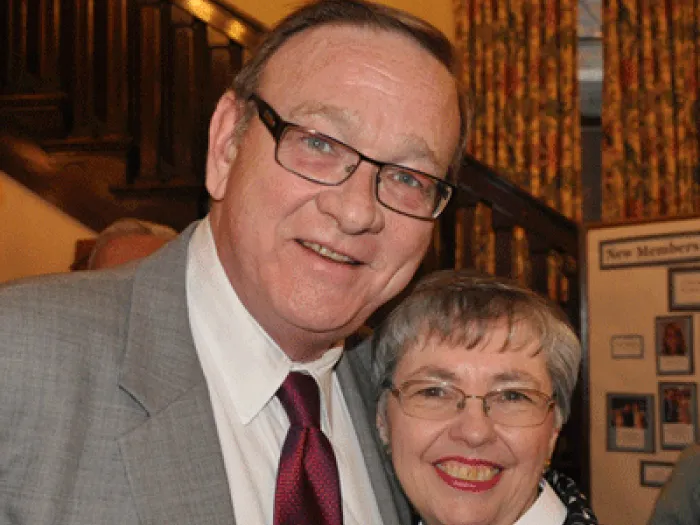Understanding the nation’s moral divide
University of North Carolina scholar offers a talk and answers questions during a Synod of the Covenant and Science for the Church webinar


LOUISVILLE — Last week the Synod of the Covenant turned to its partner, Science for the Church, to arrange a talk and question-and-answer session on a timely topic, “The Psychology of Polarization.”
The Rev. Drew Rick-Miller, Science for the Church’s Project Co-Director, introduced Dr. Kurt Gray, a social psychologist, researcher and teacher at the University of North Carolina at Chapel Hill and the author of the upcoming book “Outraged: Why We Fight About Morality and Politics and How to Find Common Ground.” Watch the 87-minute webinar hosted by the Synod of the Covenant’s executive, the Rev. Dr. Chip Hardwick, ">here.
Science for the Church exists “to strengthen the church through engagement with science,” Rick-Miller said. “We find that works best by connecting with scientists” who can “bring insights to a wide range of topics.”
Gray, who also directs the Deepest Beliefs Lab and the Center for the Science of Moral Understanding at the University of North Carolina, labeled his talk — which included a lengthy question-and-answer session — “Understanding Moral Divides.” Much of the material he presented will be in “Outraged,” which will be published on Jan. 25, 2025.
Why study morality? “Probably no one woke up today thinking, ‘You know what? I’m a monster. People think I’m evil and I like being evil,’” Gray said. “That’s the thing about elections: Everyone thinks they’re doing the best — for themselves and for their country.”
Gray said the work he and others have done reveals the reason we disagree about who to vote for is that those on the opposing side “are endorsing different issues that have different moral opinions attached to those.” For the first time since the Civil War, “how much we hate our outgroup is now much stronger than how much we love our ingroup.”
A favorite study from a few years ago looked at how much time people were sitting together to eat their Thanksgiving dinner. At tables with significant political disagreement, the meal ended about 30 minutes sooner. “Those folks got angry enough at each other that they barely sat around for pie,” Gray noted, “and we all know that pie is the very best part of Thanksgiving dinner.”
According to Gray, a person’s moral mind revolves around harm. Who is the real victim? How best to protect ourselves and the vulnerable? For example: do guns help keep families safe, or do they ultimately harm people?
As moral people, we’re trying to protect ourselves and vulnerable people from harm, but the other side seems bent on destruction. “They want to burn it all down,” Gray said, but that destruction narrative is a myth. It’s rooted in the idea that humans evolved from predators. In fact, we evolved as prey, he said.
“We are weak and slow and not strong,” he said. “Our ancestors hid in trees and caves. … Humans evolved worrying about protecting ourselves.”
“We all worry about predators,” he said, “and we see them everywhere. The reason we get so outraged is because we feel vulnerable to harm,” especially in social media spaces.
He and his colleagues identified four clusters that people think about when protecting the vulnerable. They are:
- The environment, such as coral reefs and rainforests
- The othered, including undocumented immigrants and trans people
- The powerful, such as corporate leaders and state troopers
- The Divine, including Jesus and the Bible.

Those on the political left are more supportive of the first two groups, and those on the right the last two. If we zoom out a bit, “progressives see invulnerable oppressors versus vulnerable oppressed, which is why they’re so committed to fight inequality.” Conservatives “see the world less in terms of groups and more in terms of individuals.” Centrists, he said, “see merit on both sides.”
“Keep in mind that the other side is not evil,” Gray said, “but makes different assumptions about harm.”
He had suggestions on bridging the moral divide by, for example, inviting people to tell you about their personal experiences — and listening to what they have to tell you.
Gray then answered a number of questions, beginning with the “moral panic” that social media groups can engender. “People who use social media for politics and who pay attention to the metrics” often “show symptoms of PTSD that are above a reliable threshold. If that’s you, I encourage you to spend less time on social media looking at what threats are spreading. Just put down your phone,” Gray suggested.
There’s a saying that “people buy painkillers more than vitamins” because they’re worried about threats, “and I know that’s true about elections,” Gray said. “There are messages on both sides,” although “maybe the threats are different. I think the drive to motivate you to stop something bad is powerful.”
One participant identified himself as “an argumentative person” who, knowing that, shies away from political discussion. “But I want to understand why people feel the way they do about things. Is this a common problem?”
“In general, humans are not fantastic about self-insight,” Gray said. Our perception of the facts shifts because of our moral commitments. “Should we protect the families fleeing violence at the border, or the citizens who might be harmed? It comes down to deep convictions, maybe moral convictions.”
A colleague who works to facilitate discussion “on really tense issues including the Middle East” likes to say it takes half a second to trigger our fight-or-flight response, but 20 minutes for the parasympathetic nervous system “to ramp everything down.”
“Recognize that people will say things that [anger you] because these things are hard to talk about,” he said. “You can say, ‘Let’s set aside the incendiary language to get at the issue.”

Rick-Miller wondered how those on the call could translate these findings into church work. He asked Gray for best practices or lessons learned from his research.
Churches are a bit of a paradox, Gray said. “They’re intentional spaces where people come together to feel a sense of oneness with the Divine. That should make it easier, because folks share a similar belief set. At the same time, you agree on so much that when there is disagreement, it seems very obvious, and that can be challenging.”
There is work suggesting that “because God is unknowable and the Bible is subject to interpretation — and there are questions of discernment when we talk about the will of the Divine — this ambiguity actually makes people feel more confident that they know what God thinks,” Gray said. One study asked people what they think about their state’s marijuana laws and what God thinks about them. “What are the chances,” Gray said with a smile, “that the Supreme Intelligence who created the universe thinks it’s OK to light up a joint after work, exactly like you do? It seems unlikely.”
Gray has spoken with pastors who tell him they feel “hamstrung by the moral convictions of their congregants who think they know the moral convictions of the Bible and God better than [the pastor]. It’s a challenging space,” but one where pastors and other faith leaders “can set up the guardrails as well or better than anybody.” The challenge comes because “people need to be open to others’ expression of faith.” Gray recommends getting “people together in person and start with sharing people’s common beliefs, their common convictions. Then you can get people to talk about their politics and strive for understanding. It is challenging in the church, for sure.”
One of the oldest and most validated theories in social psychology is the social contract theory, Gray said, and one of the best ways to bridge divides is by allowing people to contact each other in “sustained, meaningful contact where people feel like equals.” That level of contact can include helping to construct a house with other Habitat for Humanity volunteers or cooking a weekly dinner for people in the community who are hungry.
One person on the call said he “can’t help but think we as pastors are in a position to bring about what Paul calls a ministry of reconciliation. We have an audience every Sunday and throughout the week with whom we can cultivate empathy and enter into a safe space to talk about these issues. We invite people to move beyond judgment, anger and hurt toward healing and restoration,” which can “help us focus on common values, instead of people stewing in their differences.”
“Our desire to be heard is a factor in how to navigate this,” Rick-Miller said. “There are interesting ways science can be brought to bear on issues we find important in the church and help us to think about them in fresh new ways” and “understand more deeply what’s going on within us and between us.” Scientists like Gray can also offer guidance on “what’s been tested and works,” Rick-Miller said.
Again in partnership with Science for the Church, the Synod of the Covenant’s next webinar on “The Psychology of Polarization” is set for 10 a.m. through 11:30 a.m. Eastern Time on Oct. 24. Dr. Daryl Van Tongeren, Professor of Psychology and the Director of the Frost Center for Social Science Research at Hope College in Holland, Michigan, will be featured. Learn more and register here.
You may freely reuse and distribute this article in its entirety for non-commercial purposes in any medium. Please include author attribution, photography credits, and a link to the original article. This work is licensed under a Creative Commons Attribution-NonCommercial-NoDeratives 4.0 International License.




